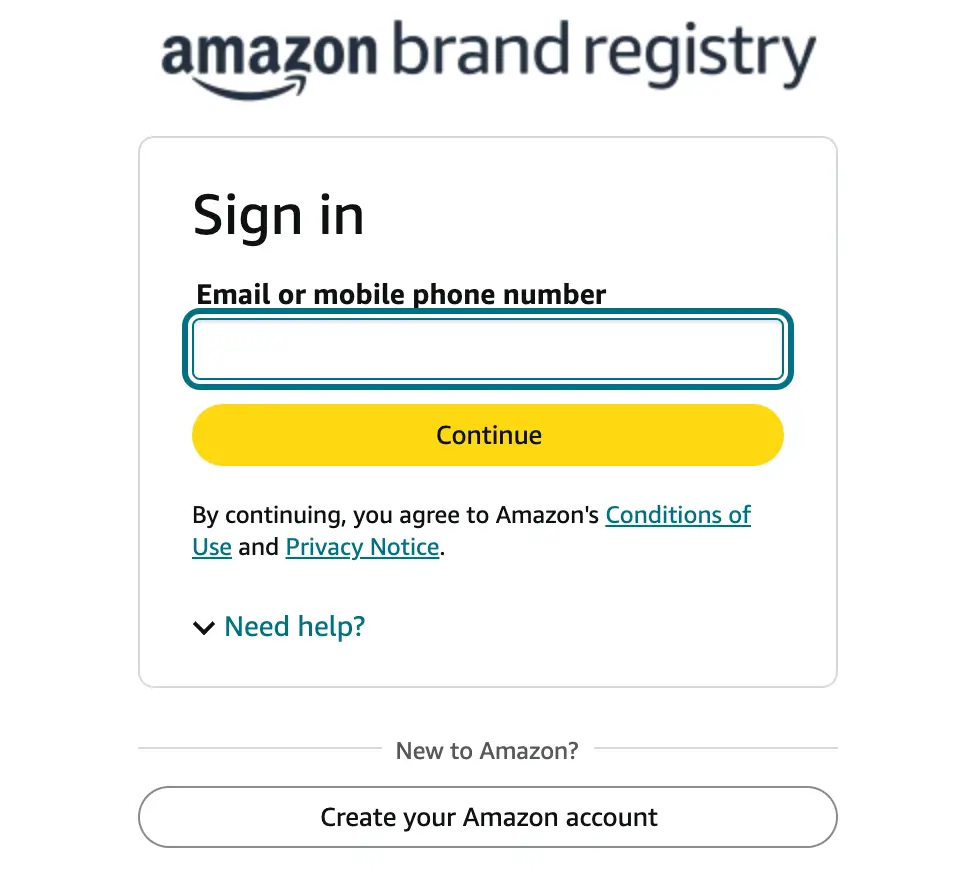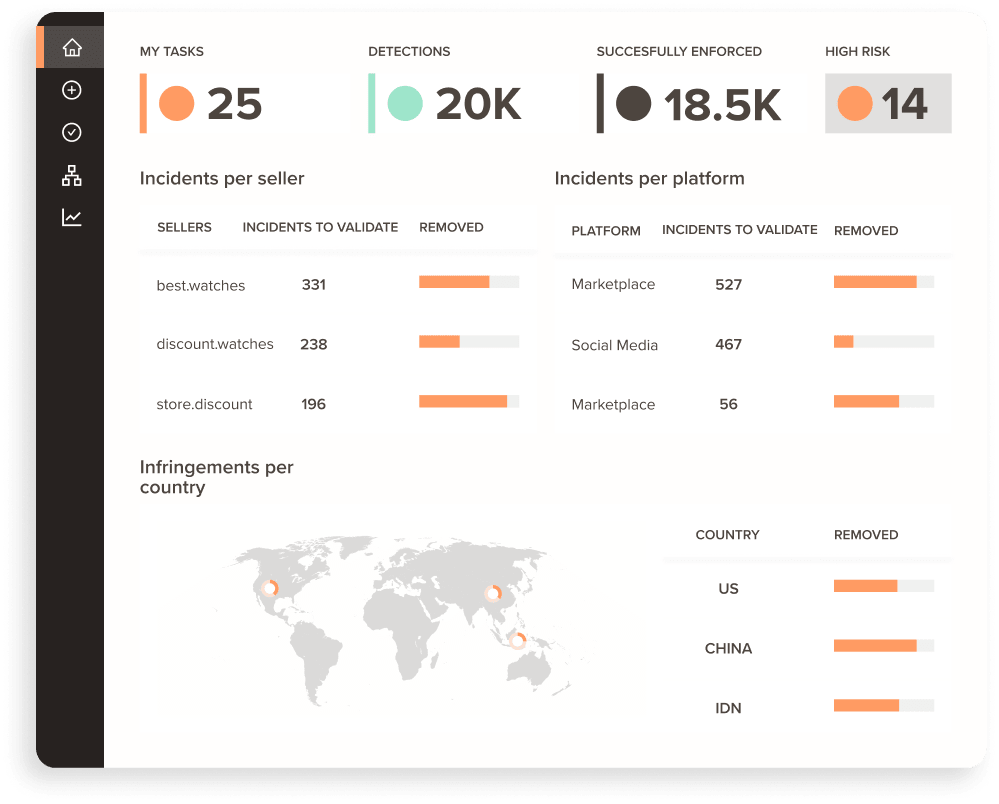Are unauthorized sellers hijacking your Amazon listings and wasting your ad spend?
Fake sellers can put your company under pressure, especially if you depend on Amazon for a large portion of your revenue.
However, you aren’t alone, since many brands struggle with infringement on the platform.
You can report and remove unauthorized sellers on Amazon in a few steps with its Brand Registry tool.
We’ll show you how to start your brand profile and use the tool below, though there can be limitations. For example, it requires manual effort to uncover unauthorized sellers and complex cases might not be resolved right away.
At Red Points, we provide AI-powered brand protection with automatic detection on Amazon. We process 72 million links per day on the platform and have a 96% enforcement rate.
Read on to learn how to combine Amazon and Red Points to protect your IP on the platform.
Step-by-step guide: Report and remove unauthorized sellers on Amazon
Unauthorized sellers can dilute your ad spend and steal customers on Amazon. However, you aren’t powerless to respond. Acting swiftly and strategically is essential. Reporting sellers starts by joining Amazon’s Brand Registry then collecting your evidence and filing reports.
1. Enroll in Amazon’s Brand Registry
Amazon’s Brand Registry is the best way for brands to report unauthorized sellers on the platform. Once you create a profile, it acts as your headquarters to report sellers based on your intellectual property registrations.
To be eligible, you must have an active or pending trademark registration. The trademark has to be a word mark or design mark approved by IP offices like the USPTO or EUIPO.
The Brand Registry provides multiple benefits for brand protection like:
- Proactive counterfeit prevention from Amazon
- Detect and report violations quickly
- Track brand protection stats and monitor removals
- Remove counterfeits immediately with Project Zero
- Use codes to prevent counterfeits with Transparency
- Access Amazon’s Counterfeit Crimes Unit
The Brand Registry also benefits you if you have a seller account on Amazon:
- A+ Content tools for better listings
- 3D shopping tools
- Brand stores, sponsored brands, and posts
- Advanced analytics and metrics
To be clear, you can make a Brand Registry account and use the reporting feature whether or not you sell products on Amazon. You do have to be a rights holder or authorized agent to register.
Amazon has other forms for reporting policy violations if you aren’t the rights holder. However, brands with trademarks should use the Registry whenever possible.

To get started, visit the Brand Registry. Next,
- Click Sign Up and create an account with the same credentials as your seller account if you have one.
- Provide information like your trademark details, brand name, logo, and supporting documentation.
- Add photos of your product and/or packaging showing your brand name.
- Verify your identity as the rights owner or authorized agent and submit the application.
Creating a new account can take a few days to a few weeks to be approved.
2. Gather evidence of unauthorized sellers on Amazon
The next step is to gather evidence of the unauthorized sellers. Accurate evidence is key to making sure Amazon’s team can validate your claim and remove the listing. You can report copyright, trademark, and patent infringements:
- For copyright infringement: Amazon recommends doing a test purchase to make sure the physical product or packaging infringes your copyright. Then, provide the order ID number in the violation tool.
- For trademark infringement: Amazon also recommends a test purchase for trademark infringement. You can only report trademark infringement for the jurisdiction where your registration is in effect.
- For patent infringement: This infringement report requires a court order, International Trade Commission (ITC) order, or Amazon Patent Evaluation Express (APEX) ID to complete.
It’s also a good idea to take screenshots of the offending listings to show the seller information, product images, and pricing.
3. Use the Brand Registry tool to report an unauthorized seller
Now you’re ready to use the Report a Violation tool in the Brand Registry. At this point, Amazon already has all your trademark information, so you don’t have to re-upload documents. You do have to choose which type of IP applies to your report.
Upon creating a new report you’ll see you can search Amazon’s listing database in different jurisdictions. As we mentioned above, IP applies per jurisdiction. So if you’re reporting a seller in the USA, your IP registration must cover the USA as well.
Be as accurate as possible when you fill out the form. This includes:
- Correct ASINs (Amazon Standard Identification Numbers)
- Detailed descriptions of each complaint
- Reference the specific IP registration for each listing infringement
- Test buy information
Amazon’s Seller Central provides more tips on filling out the violation form. One post recommends using complete and factual information in your description. For instance, if your product listing says the item is 16 inches long but the test buy shows a product that’s 10 inches, write that down.
Accurate information helps your report to be approved faster, and it helps train Amazon’s algorithms to automatically take down some listings automatically.
4. Escalate the issue with seller support if needed
It can take a few days for your violation report to be reviewed and accepted. You should receive more communication if Amazon needs further information on the report. But if you haven’t heard anything after a week or more, we recommend reaching out to seller support for assistance.
Be persistent and record your conversations with seller support since you might work with multiple agents. Take down the case ID, names, and dates of your contact.
Be aware that sellers can file a counter-notice. Some even do this knowing they are selling counterfeit products. In this case, you have 10 days to begin legal action to keep the infringing product off Amazon.
5. Leverage third-party tools and experts
Navigating the Brand Registry on your own is doable, but it can help to have someone in your corner with you.
At Red Points, our AI-powered brand protection software scans marketplaces like Amazon for infringements daily. We can enforce trademark violations on Amazon on your behalf and defend your IP to stop unauthorized sellers right away.
Some violations on Amazon are more complex than others. For example, what if the seller doesn’t actually ship an item after you complete a test buy, but you know they’re using your IP to commit fraud and steal customers? You might go back and forth with Amazon’s customer service as they try to understand the issue.
This is where our team can help since we’ve been working with Amazon for many years. Our relationship enables us to scale accurate enforcements for brands large and small. We have a 96% enforcement rate across Amazon domains. This means you don’t have to go back and forth with Amazon’s support to defend your claim with us on your side.
6. Strengthen your case with legal action
Pursuing legal action can be necessary if a seller refuses to comply or you’re dealing with multiple infringements that keep coming back. In addition to detecting and removing infringements, we also offer a Revenue Recovery Program that combines AI detection and expert litigation. This involves uncovering organized counterfeit operations and filing lawsuits to recover funds for brands. Done at scale, this effectively deters fake sellers from resurfacing.
Mistakes to avoid when reporting unauthorized sellers on Amazon
Here are a few things to avoid as you create Brand Registry reports:
Lack of follow-up: Just because one complaint is accepted doesn’t mean the unauthorized seller won’t reappear differently. It’s important to get in the habit of using the Registry to search for infringing listings regularly.
Insufficient evidence: Don’t report unauthorized resellers without having solid proof. Not providing enough information (accurate ASINs, supporting IP documents, screenshots) can drag out the process and allow the seller to take more of your revenue.
Unregistered IP: The Brand Registry works best when you have active registrations. It allows you to describe trademark registrations that are pending, but this can lengthen the process.
The problem of unauthorized resellers on Amazon
Unauthorized resellers are gray market sellers that undercut your buy box pricing and sell products in the wrong jurisdiction. There are three key stages to defending your brand from unauthorized resellers: identify rogue sellers, monitor pricing, and send cease and desist letters to unlawful dealers.
Step 1: Identify rogue sellers
Before you can take any action, you must first identify the target. Today, an automated monitoring system can scan marketplaces, seller websites, and grey market websites to seek instances of your brand and items.
A monitoring system can also work to draw the connections between various seller accounts uncover contact information and make Amazon’s unauthorized sellers enforcement more effective. With information on unauthorized resellers on Amazon, you may also identify how they obtained your products to see which of your distributor contracts need improvement.
Step 2: Monitor pricing
MAP monitoring software can be used to verify that the dealers in your supply chain are adhering to your MAP policy in addition to identifying unauthorized resellers. This makes distribution contract administration easy. When an Amazon seller violates your policy, you’ll be alerted to the situation thanks to ongoing monitoring. You can move rapidly and keep your pricing power in the market.
Step 3: Notify/send cease and desist to unauthorized dealers
To deal with and stop unauthorized resellers on Amazon, as well as authorized sellers who are selling below MAP, you now have two types of notifications at your disposal. The last step is to notify these parties properly. You don’t want to send a cease and desist letter to a genuine vendor and maybe destroy the relationship, after all. It’s perfectly acceptable to notify a genuine company that they are in violation of the MAP and detail the steps you’ll take to enforce it.
But suppose you discover illegal vendors that haven’t agreed to your MAP policy and aren’t affiliated with your company. It’s at this point when cease-and-desist letters come into play. It’s also possible to argue to Amazon that new products require your warranty, but that the seller is unable to provide it since they are an illegal reseller. This can give you another approach to stop unauthorized sellers, remove the listing, and fix the issue.
What’s next
Proactively protecting your brand from unauthorized Amazon sellers is critical. Bad actors pose a threat to your brand’s reputation both on and off Amazon. You can secure your IP by joining the Brand Registry, uploading your trademark documentation, and submitting takedown requests. But without active monitoring, new sellers can fall through the cracks.
By leveraging our expertise in AI-powered brand protection, you can detect unauthorized sellers and enforce your IP 24/7. Our strong relationship with Amazon means we can fast-track enforcements when manual complaints with small issues might stall. Reach out for a quick demo today to see how you can remove unauthorized sellers with our Amazon brand protection services.







